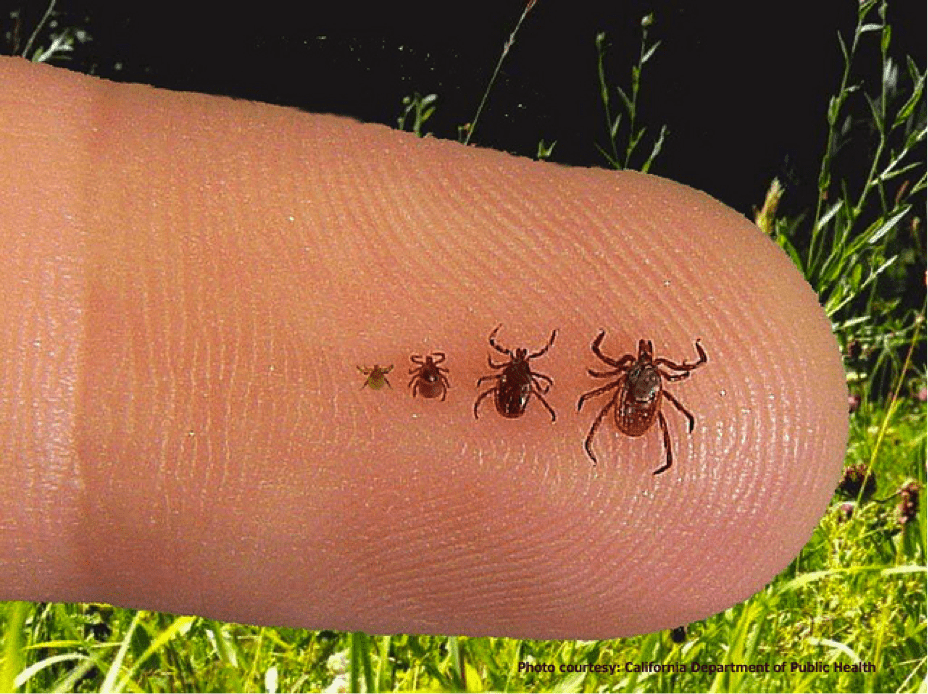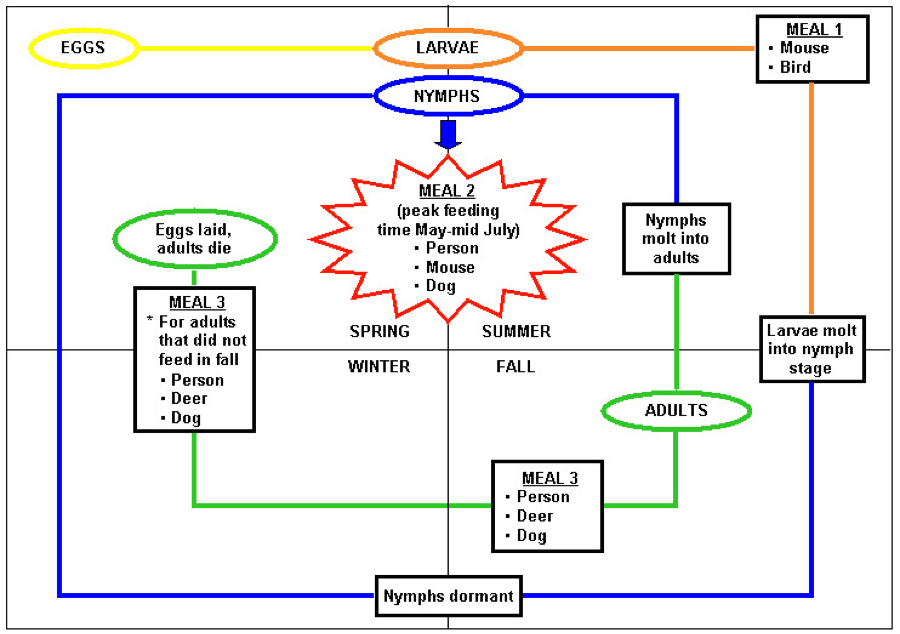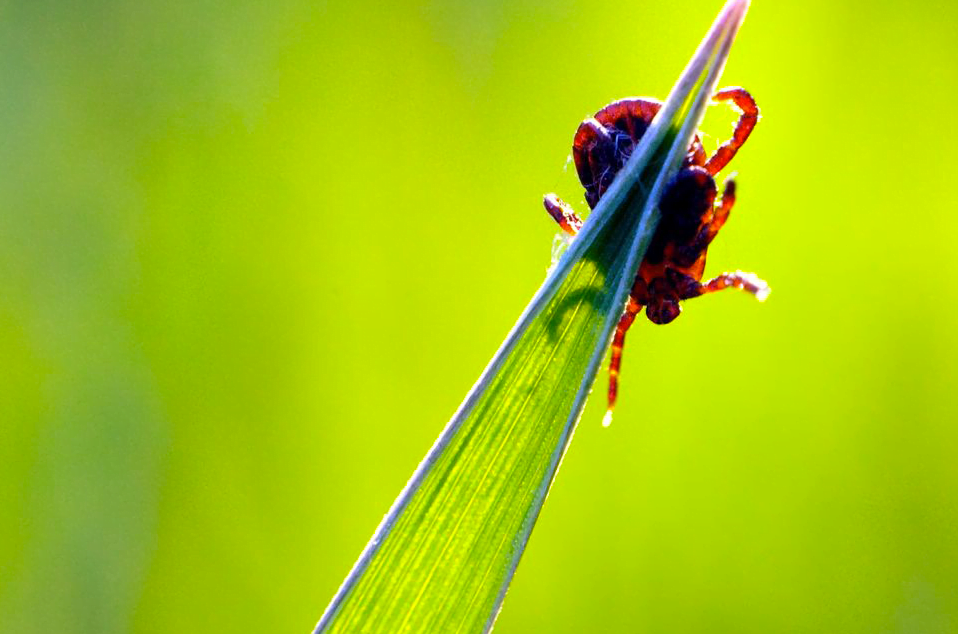Consider a Tick Spray – Ticks are a serious business.
The winter seems to finally be ending. Trees are blooming and your grass is growing and getting green again. You may even be thinking about your first barbecue. With Memorial Day Weekend approaching and people spending more time outdoors, Red Cedar reminds Hudson Valley residents to take precautions to prevent diseases that are transmitted by ticks. Ticks are the unseen enemy just waiting to pounce.
Ticks and tick-borne diseases are a growing problem throughout Dutchess County, and it’s important for property owners to understand the seriousness of this issue.
The most commonly encountered ticks in New York State are Black-legged deer tick, American dog tick, and Lone star tick. The Lone star tick and the American dog tick are not known to transmit Lyme disease.
Black-legged deer ticks, however, can transmit Lyme disease. Lyme is a bacterial infection transmitted by infected deer ticks, which are most active when temperatures are above freezing temperatures.
Deer ticks become active in the spring and are in full force in the summer months because that’s when the deer tick nymph population is most prevalent. These poppy seed sized ticks are concentrated heavily in Eastern North America, so if you live within their range, this type will be your biggest worry.

So let’s get prepared to understand how to attack control their population and defend against them through education, awareness, and prevention.
Life cycle of the deer tick
The first step in controlling the tick population is to understand their lifecycle.
Deer ticks have a two-year life cycle. Adult ticks lay their eggs in the early spring at the end of their two-year life cycle. As the eggs are laid, the older ticks die off and the next generation larvae being to grow and look for their first meal in the summer.
After their first meal, the larvae molt into the nymph stage and become dormant in the fall and winter. The following spring the nymphs look for their second meal and in their second summer, they become an adult, subsequently looking for their third meal in the fall. After their third meal, ticks are relatively large and will finish their cycle by laying eggs.

The best time to kill ticks is when they are in the vulnerable larvae and nymph stages, before either generation has reached adulthood. Adult ticks are more resistant to pesticide then the younger nymph and larvae of spring. Therefore, the best time to defeat this pest is after the hardened adult has given birth, has died, and what is left in your landscape is a majority of ticks at the nymph or larvae stage at springtime.
Tick habitat
Now that we know when to start our attack on these pests, we need to know where to find them.
The best place to treat for ticks is at woody or bushy areas along the edge of your lawn. Ticks live in wooded brushy areas that provide food and cover for their favorite prey, the white-footed mouse, deer and other small mammals. These areas also provide the humidity that the ticks need to survive. Ticks are not generally found in sunny open lawns because the cover for their prey and the humidity they require are not present.
Ticks are especially skilled at learning how to survive, despite attempts to eliminate them. So when property owners see potential issues or concerns, such as ticks on their dog or kids, it’s important for them to be proactive and contact their pest management providers promptly.
Lyme disease affects both people and pets. Dogs are much more affected by ticks than cats because dogs are more likely to wander around and into favorable tick territory.
Outsmart ticks with smart plant health care
It is important to include tick management in your plant health care strategy. Red Cedar’s trained technicians understand tick habitat and the treatment methods available to help minimize risks of contact with ticks and prevent infestation. Red Cedar also knows how to create and manage landscapes that are less susceptible to tick infestations.
Safer, affordable tick prevention
After an inspection of the property, Red Cedar will treat as necessary to help homeowners protect their houses, family, and pets.
Typically, at least 3 spray applications a year – early spring (April and May) and mid-June when new larvae and nymph ticks are emerging, and a 3rd application in late summer-fall to reduce adult ticks. In some cases, a 4th spray in late fall is also necessary.
The spray is generally only applied to the grass along the perimeter of your property and shady perennial borders and beds. This program can significantly reduce tick numbers on a residential or commercial property.

What can you do to help prevent ticks?
While creating a tick-free zone around your home may not be entirely possible, reducing the chances that a tick will transmit a disease to people or pets is. Take the following precautions to help manage tick activity on your property.
- Avoid danger zones.
- Ticks are usually found in scrubby or grassy places.
- Ticks love dense tree growth, overgrowth bushes, leaf litter, and tall grass.
- Deer ticks prefer moist, shady, wooded areas, with leaves, low-lying plants and shrubs where they can avoid drying out.
- Think sunny. Ticks don’t do well in dry, open areas.
- Keep lawns mowed and edges trimmed.
- Keep the ground under bird feeders clean so as not to attract small animals that can carry ticks.
- Clear weeds and tall grass from around the house, rock or wood piles, and at the edges of gardens and stone walls.
- Avoid sitting directly on the ground or on stone walls.
- Children’s playing and gardening are some of the riskiest activities for picking up ticks around the home.
- Keep swing sets, hammocks, and picnic tables in sunny, dry areas of the yard.
- Fewer ticks are found in the sunny, manicured areas of the lawn.
- Ticks are most common in humid climates.
- Tick nymphs rapidly lose moisture because they have leaky outer cuticles, so they can’t survive in environments with lower than 80% humidity for more than eight hours.
- Avoid sitting directly on the ground or on stone walls.
- Clear all leaf, brush and garden litter out of your yard.
- Keep the ground under bird feeders clean to not attract small animals that can carry ticks.
- Children’s playing and gardening are some of the riskiest activities for picking up ticks around the home.
- Keep swing sets, hammocks, and picnic tables in sunny, dry areas of the yard.
- Check pets for ticks daily.
- If a tick is found, remove it immediately.
- Long sleeves and long pants are good protection against ticks.
- It’s easier to spot ticks on your clothes if your clothes are light-colored.
- Ticks don’t fly or jump. Ticks can only get on you if you come into contact with them. Stay on cleared, well-traveled trails.
- Keep your grass cut short.
- Prune plants, shrubs, and bushes to let it more sunlight.
- Remove leaf litter and underbrush around transition areas, including sheds and stonewalls.
- Store woodpiles off the ground and away from your home.
- Place bird feeders away from your home and only provide seed from Dec-April.
This year it’s important to protect your pets, protect your family, and protect yourself. Call Red Cedar today to reduce your risk of tick exposure.

